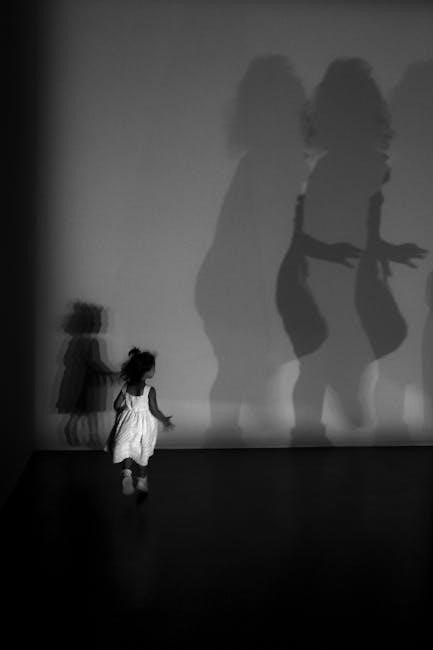Raymond’s Run, a short story by Toni Cade Bambara, explores themes of family responsibility and personal growth through the eyes of Hazel, a young athlete in Harlem.
Author Background
Toni Cade Bambara, born Miltona Mirkin Cade on March 25, 1939, in New York City, was a prominent African American writer, activist, and filmmaker. She grew up in Harlem, which heavily influenced her work, often focusing on the experiences of African American communities. Bambara was involved in the Civil Rights Movement, Black nationalism, and feminism, reflecting her commitment to social justice. She studied at Queens College and earned a master’s degree in modern American literature from the City College of New York. Known for her short stories, Bambara published works like Gorilla, My Love, which includes Raymond’s Run. Her writing often explored themes of identity, family, and societal challenges. Bambara also worked in film and served as a professor, leaving a lasting impact on literature and activism until her death in 1995.
Plot Summary
Set in Harlem, Raymond’s Run follows Hazel “Squeaky” Parker, a young, fiercely competitive runner determined to win the upcoming 50-yard dash. Unlike other girls, Squeaky’s responsibilities are focused on caring for her older brother Raymond, who has special needs. The story unfolds over two days as Squeaky prepares for the race while navigating her protective relationship with Raymond. On the day of the race, Squeaky’s competitive spirit is challenged when she sees Raymond running alongside the track, revealing his hidden potential. This moment shifts her perspective, highlighting themes of family, growth, and understanding. Through Squeaky’s journey, Toni Cade Bambara crafts a narrative that blends sports, sibling bonds, and self-discovery, culminating in a poignant realization about what truly matters in life. The story captures the essence of childhood lessons learned through love and responsibility.

Themes
The story explores themes of family responsibility, as Hazel cares for her brother Raymond, and personal growth, as she learns valuable life lessons through her experiences.
Family Responsibility
The theme of family responsibility is central to the story, as Hazel takes on the role of caring for her brother Raymond, who requires constant supervision. Despite her youthful age, Hazel assumes a mature responsibility, ensuring Raymond’s safety and well-being in their Harlem neighborhood. Her protective nature is evident as she defends him from ridicule, showcasing her deep sense of duty and loyalty. This responsibility shapes Hazel’s identity and influences her interactions with others, highlighting the importance of family bonds and the sacrifices made for loved ones. Through Hazel’s character, Bambara emphasizes the value of prioritizing family and the ways in which such responsibilities can foster growth and understanding.
Personal Growth
The story highlights Hazel’s personal growth as she evolves from a competitive and self-focused athlete to someone who gains a deeper understanding of her brother Raymond and herself. Initially, Hazel views her role as Raymond’s caretaker as a burden, but through her experiences, she develops empathy and a new appreciation for his unique qualities. Her competitive nature is challenged when she sees Raymond running alongside her during the race, leading to a moment of realization. This transformative experience shifts her perspective, teaching her that success is not just about winning but also about supporting and valuing others. By the end of the story, Hazel’s maturity and sense of responsibility are evident, showcasing her journey toward self-awareness and compassion. This growth underscores the importance of empathy and the broader meaning of achievement in life.
Characters
The story centers around Hazel “Squeaky” Parker, a determined young athlete, and her brother Raymond, who requires constant care due to his developmental challenges.
Hazel ‘Squeaky’ Parker
Hazel, or “Squeaky,” is the protagonist of the story, a young girl known for her speed and determination. She is fiercely protective of her brother Raymond, taking on a caregiving role despite her youth. Squeaky’s identity is deeply tied to her athletic abilities, particularly her dominance in the races at school. Her confidence and competitive spirit are evident as she prepares for the upcoming race, viewing it as an opportunity to prove herself. However, her perspective shifts when she witnesses Raymond running alongside the track, leading to a moment of profound realization. Through her character, Bambara explores themes of responsibility, sibling bonds, and self-discovery, highlighting Squeaky’s growth from a focus on individual achievement to a deeper understanding of family and compassion.
Raymond Parker
Raymond is Hazel’s older brother, who requires constant care due to his intellectual and developmental challenges. Despite his age, Raymond is childlike and innocent, often misunderstood by those around him. Hazel is fiercely protective of him, defending him against any mockery or harm. Raymond’s presence in the story serves as a catalyst for Hazel’s personal growth, particularly when she observes him running alongside the race track. This moment highlights Raymond’s unique qualities and the deep bond he shares with Hazel. Through Raymond’s character, Bambara emphasizes themes of family, acceptance, and the importance of understanding and supporting loved ones with special needs. Raymond’s gentle nature and resilience inspire Hazel to reevaluate her priorities and find a new appreciation for her role as his caregiver.
Symbolism
In Raymond’s Run, Toni Cade Bambara uses symbolism to convey deeper meanings. The race itself symbolizes Hazel’s journey of self-discovery and growth, as she learns to balance competition with compassion. Raymond’s presence during the race represents unconditional love and acceptance, challenging Hazel’s initial focus on winning. The act of running symbolizes freedom and escape for Hazel, while also highlighting her connection to her brother. The neighborhood of Harlem serves as a backdrop, symbolizing community and cultural identity. Even the blue ribbon, often a symbol of victory, takes on a different meaning as Hazel realizes that true triumph lies in understanding and supporting others. Through these symbols, Bambara explores themes of family, responsibility, and personal transformation, enriching the narrative with layers of emotional and cultural depth.
Style and Structure
Toni Cade Bambara’s Raymond’s Run is crafted with a unique narrative style, employing first-person present tense to create immediacy and intimacy. Hazel’s voice is direct and conversational, reflecting her strong personality and emotional journey. The story’s structure unfolds over two days, building tension as Hazel prepares for the race and confronts her rival, Gretchen. Bambara uses dialogue and internal monologue to reveal Hazel’s thoughts and feelings, adding depth to her character. The narrative is tightly focused, with a clear turning point when Hazel sees Raymond running alongside the track, symbolizing her shift from competitiveness to compassion. The concise structure and vivid descriptions emphasize themes of family, responsibility, and personal growth, making the story both powerful and memorable. Bambara’s style effectively blends humor, realism, and emotional resonance, capturing the essence of Hazel’s transformative experience.

Cultural Significance
Raymond’s Run holds significant cultural value as it portrays life in Harlem through the eyes of a young African American girl. Toni Cade Bambara’s work often highlights the experiences of Black communities, addressing themes of identity, family, and societal expectations. The story challenges stereotypes by presenting strong female characters and exploring the complexities of sibling relationships. Hazel’s journey reflects the resilience and resourcefulness common in urban environments. The narrative also touches on civil rights and Black empowerment, as Bambara was an activist and filmmaker involved in these movements. Raymond’s Run is celebrated for its authentic representation of African American life, making it a vital piece of contemporary literature. Its inclusion in educational curricula underscores its relevance in fostering cultural understanding and appreciation. The story continues to resonate with readers, offering insights into the richness of Black culture and heritage.

Educational Use
Raymond’s Run is widely used in educational settings for its rich themes and relatable characters. The story is often included in middle school and high school curricula to teach literary analysis, cultural awareness, and critical thinking. Educators appreciate its exploration of family dynamics, personal growth, and social responsibility, making it a valuable tool for discussing real-world issues. The narrative’s clear structure and vivid imagery also help students practice identifying plot elements, character motivations, and symbolic meanings. Additionally, the story’s brevity and accessibility make it ideal for teaching close reading and writing skills. Many schools provide digital copies, such as the raymonds_run.pdf, to ensure easy access for students. Study guides and online resources further enhance its educational value, offering detailed analysis and discussion questions to deepen understanding. This story remains a staple in classrooms for its educational versatility and relevance.

Availability and Access
Raymond’s Run is widely accessible in various formats, ensuring its availability for readers and students. The story can be downloaded as a free PDF file (raymonds_run.pdf) or read online. It is also included in educational materials, such as the Holt Elements of Literature textbook, starting on page 39. Many schools provide digital copies for easy access, and study guides are available to enhance understanding. The story is part of Toni Cade Bambara’s collection, Gorilla, My Love, which is available in bookstores and libraries. Online platforms offer summaries, analyses, and teaching resources, making it a convenient choice for educational use. Its widespread availability ensures that readers can engage with the story in multiple ways, fostering a deeper appreciation of its themes and characters.
Raymond’s Run by Toni Cade Bambara is a poignant and uplifting story that explores themes of family, responsibility, and personal growth. Through Hazel’s journey, the story highlights the importance of sibling bonds and the transformative power of love and understanding. The narrative also underscores Hazel’s maturation, as she shifts from competitiveness to compassion. Bambara’s vivid portrayal of Harlem’s vibrant culture and the relatable struggles of its characters have made this story a timeless classic. Its accessibility in various formats, including free PDF downloads and educational materials, ensures its continued relevance for readers and students. Raymond’s Run remains a powerful tool for teaching empathy, cultural awareness, and the significance of family, leaving a lasting impact on its audience.